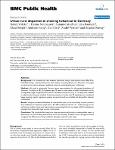Urban-rural disparities in smoking behaviour in Germany
Völzke, Henry
Neuhauser, Hannelore
Moebus, Susanne
Baumert, Jens
Berger, Klaus
Stang, Andreas
Ellert, Ute
Werner, André
Döring, Angela
Background: It is currently not clear whether individuals living in metropolitan areas differ from individuals living in rural and urban areas with respect to smoking behaviours. Therefore, we sought to explore the relation between residential area and smoking behaviours in Germany. Methods: We used a nationwide German census representative for the general population of Germany. A number of 181,324 subjects aged 10 years or older were included. Information on the average daily usage of cigarettes that have or had been smoked formerly or currently was available in subjects who have ever smoked. A daily consumption of more than 20 cigarettes was considered heavy smoking. Logistic regression analyses were performed sex-stratified and adjusted for relevant confounders.Results: Analyses revealed inhabitants of metropolitan areas to be more likely current smokers than inhabitants of rural areas (odds ratio 1.56, 95%-confidence interval 1.51; 1.62). Among current and former smokers those who lived in urban communities had also increased odds for being heavy smokers than those who lived in rural communities. Conclusion: We conclude that living in an urban and particularly living in a metropolitan area is a determinant of both smoking and severity of current smoking. Tobacco control programs should recognize the difference in living conditions between rural and urban areas.
No license information

